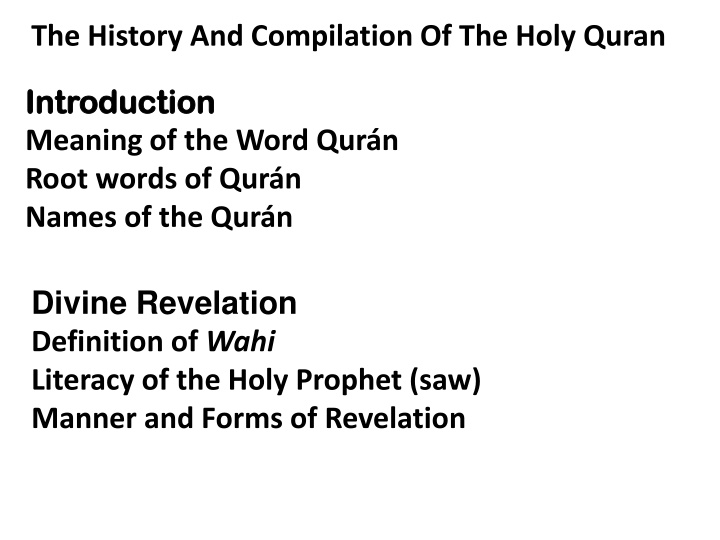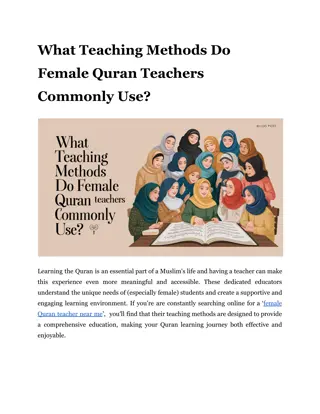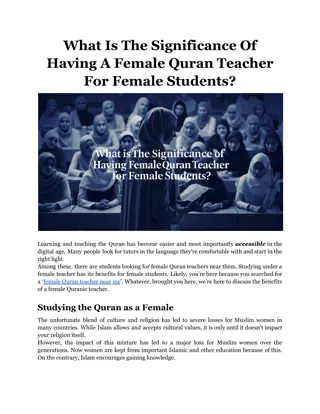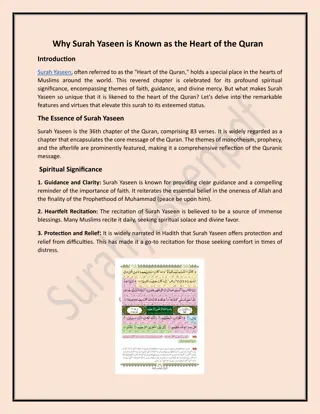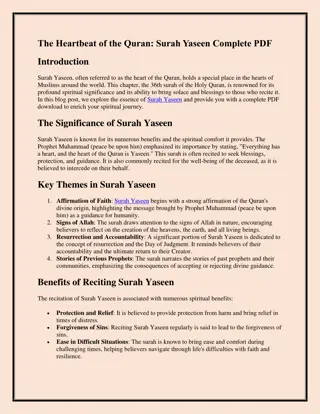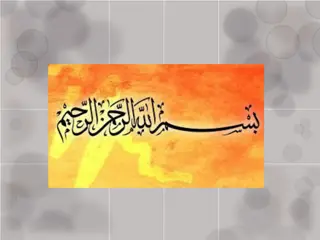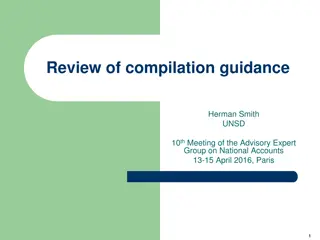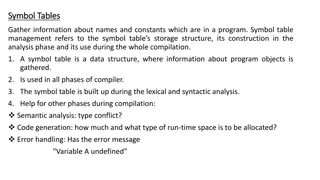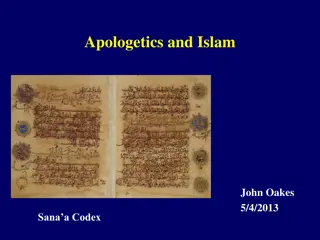Compilation and Significance of the Holy Quran: A Comprehensive Insight
Delve into the profound exploration of the holy Quran, uncovering its divine revelations, stages of compilation, and the linguistic intricacies behind its root words. Discover the historical and spiritual dimensions that make this sacred text a beacon of guidance and wisdom.
Download Presentation

Please find below an Image/Link to download the presentation.
The content on the website is provided AS IS for your information and personal use only. It may not be sold, licensed, or shared on other websites without obtaining consent from the author.If you encounter any issues during the download, it is possible that the publisher has removed the file from their server.
You are allowed to download the files provided on this website for personal or commercial use, subject to the condition that they are used lawfully. All files are the property of their respective owners.
The content on the website is provided AS IS for your information and personal use only. It may not be sold, licensed, or shared on other websites without obtaining consent from the author.
E N D
Presentation Transcript
The History And Compilation Of The Holy Quran Introduction Introduction Meaning of the Word Qur n Root words of Qur n Names of the Qur n Divine Revelation Definition of Wahi Literacy of the Holy Prophet (saw) Manner and Forms of Revelation
Process of Divine Revelation The Beginning of Revelation Revelation in Stages Recording of Revelation Revelation Period Compilation of Divine Revelation In the Life Time of the Holy Prophet (saw) In the Life Time of Sayyidina Abu Bakr (rad) In the Life Time of Sayyidina Uthman (rad)
Introduction most widely read book a source of immense inspiration, guidance and wisdom pivotal point of imaan, faith Meaning of the Word Qur n Qur an the etymological base of the Arabic language which have no comparison in the English language
threefold inquiry etymological base of each word its grammatical category its contextual location etymological base of each word Most Arabic words have a root word consisting of 3 or 4 letters root word has its own individual meaning vowel sounds of the Arabic language precise and specific meaning
Grammatical Category the context of the original matter in discussion Contextual Location as the Arabic language has an enormous breadth of vocabulary
Root Words of the Quran 1 The first root word is qara a the divine protection of Allah (swt) the exact placement of each ayah as well as the arrangement of the Surah s and their names It is for us to collect and recite it (75:17) the book which contains all knowledge of the universe
And we have sent down to thee the Book explaining all things, a guide, a mercy and glad tidings to Muslims . (16:89) 2 The second root word is qar ana union or conjunction the Qur an this refers to the literal physical existence of the Qur an and its properties. Imaam Fakr-al-Deen Razi quotes Imaam Sufyan Sorri as stating that the Holy Qur an was given its own special name because letters are joined to make words, words are joined to make ayahs, ayahs are joined to make surahs and surahs are joined to make the Qur an. This beautiful combination of literature has produced the most magnificent book in the world.
the word qarana the Qur an is combined with guidance, the two being inseparable. The Holy Qur an refers to this combination: This is the book: it is guidance sure, without doubt . (2:2) The third root word is qira athun meaning to read or recite Although other books that claim to be divinely revealed are also read and recited, the Holy Qur an has a specific characteristic, superiority and individuality compared to them
the most widely read book in the world Millions of Muslims all over the world recite it in their daily prayers 5 times a day The Qur an is read and recited daily in what is called tilawat where Muslims read the Qur an whenever they have some spare time Ramadhan the entire Qur an is recited over a period of 30 days in the special tharawih As well as being read and recited, the Qur an acts as a practical guide in all affairs of Muslims, be they social, cultural, legal, economic or political
The fourth and final root word of the word Quran is qira in which meaning evidence evidence, argument or symbol. In ayah 5 of surah Al-Fatiha: for example, man is told to ask Allah for the right path So the Qur an is self-evident and self-explanatory. If one verse gives a general meaning than the other gives a more specific definition.
Fourteen hundred centuries have passed and no change or alteration has taken place in the Holy Qur an. The text that is present today is exactly the same text that was revealed to Prophet Muhammad (saw). This is so despite hundreds of attempts by non- Muslims to try and insert alterations and changes into the Qur an. That is why Allah (swt) himself gives it divine protection: We have, without doubt, sent down the message; And We will assuredly guard it (from corruption . (15:9)
Just as there have been no alterations made to the Quran, similarly there are no conflicts or contradictions in the text of the Holy Qur an. If one reads the beautiful verses each one compliments the next. The surahs and ayah s of the Qur an work in consistent harmony with each other. The Holy Qur an is truly a uniform piece of work. In contrast the Encyclopaedia of America for example states that there are about 30,000 errors in the text of the bible and in its various versions. Although the accuracy of this type of observation is open to debate, what is clear is that any book that claims to be divinely revealed would surely not even entertain one error let alone hundreds or thousands of errors. The very nature of God, His Omnipotence, All Knowing and Most Powerful nature presupposes that His divinely given book would be clean of all mistakes. Indeed the Holy Qur an is a living testament to that fact
Names of the Holy Quran The word Qur'an itself can be found in the scriptures: "We do relate unto you the most beautiful stories, in that We reveal to thee this (portion of the) Qur'an: Before this thou too was among those who knew it not." (Yusuf, 12:3)
However Allah Almighty refers to the Holy Qur'an using several other names: al-nur the light (7:157) al-hukm the judgment (13:37) al-dhikr the reminder (15:9) al-kitab the scripture (21:10) al-furqan the criterion (25:1) al-tanzil the revelation (26:192) Further descriptive titles include mubarak (blessing)[5], mussadiq (confirm ation of truth)[6], mubin (explanation)[7], hakim (wisdom) [8], majid (glorious)[9] and karim (honoured)[10]
Divine Revelation Definition of Wahi The Arabic word wahi comes from the root word waha and is used to describe divine revelation. It has a variety of different meanings in the Arabic language, being interpreted as a quick or divine indication , to give or convey a message or gentle speech . In Islamic terminology, wahi can be precisely defined as God s divine message conveyed to Allah s chosen persons (Prophets). This message can be conveyed openly or in a hidden and concealed manner, imparting wisdom and knowledge that is beyond the material and physical realities of man So we sent this inspiration to the mother of Musa (28:7)
Literacy of the Holy Prophet (saw) It was during one of these periods, in the year A.D 610 that the first revelation of the Qur an began. In a Hadith related by Ayesha[11] (r.a) the Angel Gibraeel (a.s) came to the Holy Prophet (saw) and said ikra, Read! . He replied: I am not a reader . The Angel then held him, pressed him hard and released him and again said ikra, Read! . The Prophet replied: I am not a reader . The angel held and pressed him hard for a third time and said: Read, in the name of your Lord who created. It is He who created man from clots of blood. Read! Your Lord is the most bounteous, Who has taught the use of the pen. He has taught man what he did not know . (Al-Alaq, 96:5 )
Manner and Forms of Revelation The Holy Qur an was revealed to the Holy Prophet (saw) in a variety of different ways 1. In the form of dreams: Prophet Muhammad (saw) would sometimes receive divine revelations of the Holy Qur an in the form of dreams. Ayesha (ra) narrates that the beginning of Wahi began in the form of true dreams. Whenever the Holy Prophet (saw) would see a dream its true meaning and significance it would become clear by the morning (Bukhari).
2. Revelation revealed directly into the heart : The Holy Prophet (saw) also used to receive revelation directly into the heart. Imaam Hakim narrates that the Holy Prophet (saw) stated: Angel Gibraeel conveyed a message into my heart. That no man can die until his rizk or resources have been completed. So Man should fear God and try all means to achieve his resources. If there is a delay in receiving your due then do not go astray to achieve it for whatever you will receive will be through Allah and what he has already ordained [12].
3. Revelation disclosed upon the sound of a bell: Another method of revelation was at the sound of a bell. The Holy Prophet (saw) would hear the ringing of a bell or a musical sweet sound, which would be immediately followed by divine revelation. According to Hadrat Ayesha (r.a) once the divine revelation began, Angel Gibraeel (a.s) would come at various times with different ayahs of the Qur an. According to her, the Holy Prophet (saw) himself stated that: Sometimes wahi comes to me after a bell rings and that is a heavy time for me . (Bukhari)
4. Revelation Brought by an Angel in the Form of a Man: One of the most common ways of receiving revelation was through Angel Gibraeel (as). The Holy Qur an states: Say: Whoever is an enemy to Gibraeel for he brings down the (revelation)to thy heart by Allah s will, a confirmation of what went before , and guidance and glad tidings for those who believe, - Whoever is an enemy to Allah and His angels and apostles, to Gibraeel and Michale, - Lo! Allah is an enemy to those who reject faith ( Al-Bakarah: 2:97-98) Angel Gibraeel (a.s) would sometimes come to the Holy Prophet (saw) in the form of a man[16]. Hadrat Ummi Salma (r.a) reports that: once I saw Dhaya Qalbi in front of the Prophet (saw) talking to him. The Prophet (saw) then asked me: Do you know who this man is? I replied: That was Dhaya Qalbi By God I thought it was him but the Prophet of God (saw) later announced in his Kutbah it was the Angle Gibraeel [17]
5. Revelation Through an Angel in his True Form: Angel Gibraeel also came to the Holy Prophet (saw) in his actual angelic form. Hadrat Abdullah ibn Masood (r.a) narrates that Prophet Muhammad (saw) said: When I saw Angel Gibraeel he had 600 wings [18]. 6. Revelation Directly from God: God has directly communicated with some of His Prophets as with Prophet Musa (a.s) on Mount Toor. The Holy Prophet (saw) spoke directly with Allah (swt) during his ascent into the heavens, the Miraj. There, Allah (swt) gave divine revelation to his Holy Prophet (saw) concerning the obligatory prayers.
It is interesting to note how the differing methods of communication reach their climatic end with Kalam Elahi , Allah directly speaking to His beloved. Initially Allah (swt) beckons His Prophet (saw) gently through dreams. Then revelation is communicated directly into his heart. Thereafter the Angel Gibraeel (a.s) comes with revelation in the form of a man. As the Holy Prophet (saw) draws closer and closer to Allah (swt) Angel Gibraeel (a.s) is shown in his full glory to him. Finally Allah (swt) calls His beloved Prophet (saw) to the heavens and talks to him directly in the finale of the Miraj-un-Nabi.
YEARS PERIOD MONTHS DAYS REVELATIO N PERIOD 22 2 22 MAKKI PERIOD 5 12 13 MADANI PERIOD 9 9 9
Compilation of Divine Revelation The compilation of the Holy Qur an took place in three stages: During the lifetime of the Holy Prophet (saw) During the caliphate of Sayyidina Abu Bakr (rad) During the caliphate of Sayyidina Othman bin Affan
In the Lifetime of the Holy Prophet (saw) There is ample evidence showing that the entire Qur an was written down in the Prophets (saw) lifetime. As stated earlier when he (saw) received revelation he would instruct scribes to record the revelation on parchments of paper or pieces of leather. He would also indicate in which Surah each ayah was to be placed[39]. The Companions never interfered in the arrangement of the ayahs and Surahs which are the same in copies of Qur ans available today. Hadrat Zaid bin Thabbit was one of the most prominent of the scribes and has reported that he, along with other companions would compile the Qur an in the presence of the Holy Prophet (saw)[40]. During this time the names of the Surahs were also known. Angle Gibraeel (a.s) would also come to the Holy Prophet (saw) every Ramadan to listen to him reciting the Qur an, and listened to him twice in the year of his demise[41].
In the time of Sayyidina Abu Bakr (rad) A detailed account of this is contained in an account given by Zaid bin Thabbit in Sahih Bukhari. After the demise of the Holy Prophet (saw) an imposter called Muslimah announced falsely his own Prophethood. Sayyidina Abu Bakr (rad) sent a Muslim expedition against him and a harsh battle took place in 632 A.D (11 A.H) at the place of Yamamah[42] during which hundreds of hafiz were martyred. Sayyidina Umar bin Kattab (rad) became concerned at the heavy loss of casualties, fearing that a large part of the Qur an could be lost if the rate of martyrdom increased. He expressed these fears to the Caliph Sayyidina Abu Bakr (rad) and asked him to compile the Qur n into a permanent book form.
Hadrat Zaid bin Thabbit (rad) set about completing the task. He collected all the written parts of the Qur an from date leaves, parchment and pieces of leather and also listened to many of the hafiz who recited verses from their memories. After having carefully compared and cross checked each ayah, he compiled the written Qur an into one single volume. Sayyidina Abu Bakr became its official custodian, passing on to Sayyidina Umar bin Kattab (rad) during his caliphate. After his demise the Qur anic volume was passed into the custody of his daughter Hadrat Hafsah (rad).
In the time of Sayyidina Uthman bin Affan (rad) As the Islamic empire increased it incorporated many different nations and tribes who did not speak and understand Arabic. As a result difference in reciting the Qur an and pronunciation began to occur. It is reported by Hadrat Anas bin Malik[43] that Hadrat Hudaifah bin Yaman (rad) had been involved in the victories of the Muslim run Sham, now modern day Syria, and Iraq over Armenia and Azerbaijan. He heard the differences in the recitation of the Qur an by the inhabitants there. Upon his return he related these concerns to Sayyidina Uthman (rad) who expressed a deep apprehension at this new development. They both feared conflicts could arise, replicating the problems that had occurred in the authenticity of the Bible and Toroth. Sayyidina Uthman took action and asked Hadrat Hafsah (rad) for the original volume of the Qur an promising to return it to her once copies were made. She sent it immediately to him.
Hadrat Zaid bin Thabbit, having been responsible for the first compilation (rad) was appointed as the head of a committee to make exact and perfect copies of the original. The other committee members consisted of Hadrat Abdullah bin Zubair, Hadrat Sa id bin Al A as and Hadrat Abdur Rahman bin Harith (rad). Hadrat Uthman gave them instructions that if any of the three disagreed upon any point with Hadrat Zaid (rad) then the relevant ayah should be written in the language of the Quraish as that was the tongue in which the Qur an was revealed.
Once copies were made the original was returned to Hadrat Hafsah (rad). The new copies were then distributed to every Muslim province with the orders that all other copies of the Qur an, be they full or partial copies, were to be burnt and replaced by this original one. Since that day the Holy Qur n has remained in its original pristine form and will remain as such in the future by the Grace and Blessings of Allah Almighty
